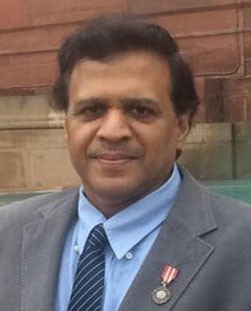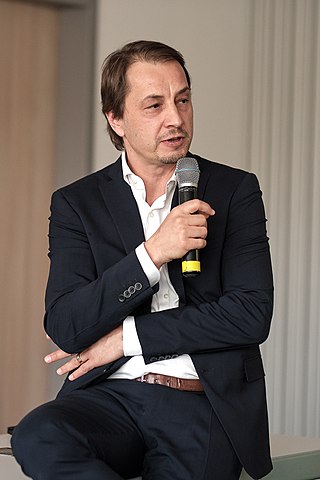
Retinitis pigmentosa (RP) is a genetic disorder of the eyes that causes loss of vision. Symptoms include trouble seeing at night and decreasing peripheral vision. As peripheral vision worsens, people may experience "tunnel vision". Complete blindness is uncommon. Onset of symptoms is generally gradual and often begins in childhood.
The National Eye Institute (NEI) is part of the U.S. National Institutes of Health (NIH), an agency of the U.S. Department of Health and Human Services. The mission of NEI is "to eliminate vision loss and improve quality of life through vision research." NEI consists of two major branches for research: an extramural branch that funds studies outside NIH and an intramural branch that funds research on the NIH campus in Bethesda, Maryland. Most of the NEI budget funds extramural research.

Amaurosis fugax is a painless temporary loss of vision in one or both eyes.

The optic disc or optic nerve head is the point of exit for ganglion cell axons leaving the eye. Because there are no rods or cones overlying the optic disc, it corresponds to a small blind spot in each eye.
The Lions Eye Institute (LEI) is an Australian medical research institute affiliated with the University of Western Australia. It was established in 1983 with support of the Lions Clubs of Western Australia and headquartered in the Perth suburb of Nedlands, Western Australia. The LEI is a not-for-profit centre of excellence that combines an ophthalmic clinic with scientific discovery developing techniques for the prevention of blindness and the reduction of pain from blinding eye conditions.

The central retinal artery branches off the ophthalmic artery, running inferior to the optic nerve within its dural sheath to the eyeball.
Vision science is the scientific study of visual perception. Researchers in vision science can be called vision scientists, especially if their research spans some of the science's many disciplines.
Stargardt disease is the most common inherited single-gene retinal disease. In terms of the first description of the disease, it follows an autosomal recessive inheritance pattern, which has been later linked to bi-allelic ABCA4 gene variants (STGD1). However, there are Stargardt-like diseases with mimicking phenotypes that are referred to as STGD3 and STGD4, and have a autosomal dominant inheritance due to defects with ELOVL4 or PROM1 genes, respectively. It is characterized by macular degeneration that begins in childhood, adolescence or adulthood, resulting in progressive loss of vision.
A visual prosthesis, often referred to as a bionic eye, is an experimental visual device intended to restore functional vision in those with partial or total blindness. Many devices have been developed, usually modeled on the cochlear implant or bionic ear devices, a type of neural prosthesis in use since the mid-1980s. The idea of using electrical current to provide sight dates back to the 18th century, discussed by Benjamin Franklin, Tiberius Cavallo, and Charles LeRoy.

The John A. Moran Eye Center at the University of Utah is an ophthalmology clinical care and research facility in the Mountain West.

Gholam A. Peyman is an Iranian American ophthalmologist, retina surgeon, and inventor. He is best known for his invention of LASIK eye surgery, a vision correction procedure designed to allow people to see clearly without glasses. He was awarded the first US patent for the procedure in 1989.
Michael David Abràmoff is an American neuroscientist, ophthalmologist, vitreoretinal surgeon, computer engineer, and entrepreneur. He is the Watzke Professor of Ophthalmology and Visual Sciences at the Roy J. and Lucille A. Carver College of Medicine at the University of Iowa.

Yog Raj Sharma is an Indian ophthalmologist and ex-chief of Dr. Rajendra Prasad Centre for Ophthalmic Sciences of the All India Institute of Medical Sciences (AIIMS), New Delhi, the apex body of the National Programme for the Control of Blindness, a Government of India initiative to reduce the prevalence of blindness in India. He is the Chairman of the Task Force on Prevention and Control of Diabetic Retinopathy Group and the Co-Chairman of the National Task Force on Prevention of Blindness from Retinopathy of Prematurity under the Ministry of Health and Family Welfare of the Government of India. An advisor to the Ministry of Health and Family Welfare, India. Sharma was honored by the Government of India in 2015 with Padma Shri, the fourth highest Indian civilian award. In 2005, Yog Raj Sharma's published article on "Pars plana vitrectomy vs scleral buckling in rhegmatogenous retinal detachment" in Acta Ophthalmologica Scandinavica and in November 2021, American society of retina specialists cited it as top 100 publications on retinal detachment management in the last ~121 years. Of these top hundred publications, only nineteen countries contributed, three of the contributing countries were Asian and from India this study was the sole contribution. Dr Sharma called it 'the singular biggest achievement of his career" in an article published in Daily Excelsior, Jammu in December 2021.
Mark S. Humayun is a Pakistani-American ophthalmologist, engineer, scientist, inventor and academic – the only ophthalmologist elected a member of both U.S. National Academies of Medicine and Engineering. He is a university professor with joint appointments at the Keck School of Medicine of USC and the USC Viterbi School of Engineering.
James G. Fujimoto is Elihu Thomson Professor of Electrical Engineering and Computer Science at the Massachusetts Institute of Technology (MIT) and a visiting professor of ophthalmology at Tufts University School of Medicine, Boston, Massachusetts.

Robert E. MacLaren FMedSci FRCOphth FRCS FACS VR is a British ophthalmologist who has led pioneering work in the treatment of blindness caused by diseases of the retina. He is Professor of Ophthalmology at the University of Oxford and Honorary Professor of Ophthalmology at the UCL Institute of Ophthalmology. He is a Consultant Ophthalmologist at the Oxford Eye Hospital. He is also an Honorary Consultant Vitreo-retinal Surgeon at the Moorfields Eye Hospital. MacLaren is an NIHR Senior Investigator, or lead researcher, for the speciality of Ophthalmology. In addition, he is a member of the research committee of Euretina: the European Society of Retina specialists, Fellow of Merton College, in Oxford and a Fellow of the Higher Education Academy.

Atul Kumar is an Indian ophthalmologist who is currently the Chief & Professor of Ophthalmology at Dr. Rajendra Prasad Centre for Ophthalmic Sciences (RPC-AIIMS), the national apex ophthalmic centre at All India Institute of Medical Sciences, Delhi. He was awarded the Padma Shri award in January 2007 for his services to the medical field. He specializes in vitreoretinal surgery and also heads the Vitreo-Retinal, Uvea and ROP services at RPC-AIIMS.
Shouleh Nikzad is an Iranian-American electronic engineer and research scientist at the Jet Propulsion Laboratory. She leads the Advanced Detector Arrays, Systems, and Nanoscience Group. Her research considers ultraviolet and low-energy particle detectors, nanostructure devices and novel spectrometers. Nikzad is a Fellow of the American Physical Society, the National Academy of Inventors and SPIE.

Peter Szurman is a German ophthalmologist, scientist, and professor of ophthalmology in Sulzbach/Saar.
Justine R. Smith AM is an Australian ophthalmic surgeon and vision researcher. Today she is based at Flinders University and Flinders Medical Centre in Adelaide, Australia. Smith was awarded Member of the Order of Australia "for significant service to ophthalmology, particularly research and education" in the 2023 King's Birthday Honours. She received the Flinders University Alumni Convocation Medal in 2022, the Gold Medal of the International Ocular Inflammation Society in 2023, and the Joanne Angle Service Award from the Association for Research in Vision and Ophthalmology in 2024.










